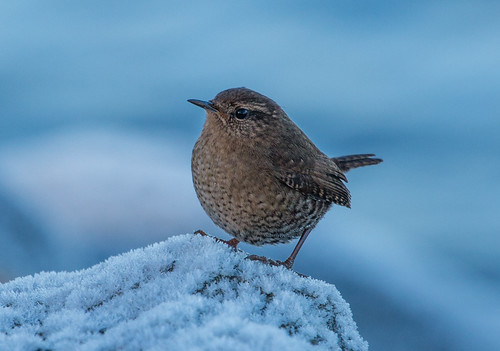In her book, The Sun is a Compass, Caroline Van Hemert mentions just a fraction of the 160 species she noticed on her 4,000-mile journey in Alaska, but those birds come to life on her pages. She describes a Pacific Wren when it “launches into an enthusiastic outburst. These birds have lungs the size of lima beans but their voices are as large as their organs are small, filling the thick air with a waterfall of sound.” When I talked to her by phone last week, I asked her if she’d tell us about when she and her husband came upon a family of Brants, small saltwater geese, along the coast of the Arctic Ocean.
 |
| Ómar Runólfsson |
We were hiking again along that narrow band between the ocean and the steep mud bluffs. Sometimes we’d have to go above and walk on the bluffs, but in certain areas we could walk along the beach more easily. We were doing that and we were making pretty good time. It was a pretty stormy day—it wasn’t too long before Pat capsized his raft in the Arctic Ocean and so we were happy to be on land.
We came up and noticed this family of Brant geese—there were two adults and three young. They were running down the beach in front of us. Obviously the little ones were—I don’t know how old they were, but pretty fresh out of the nest, pretty gangly and awkward and doing their best to keep up with their parents. As we were walking, they were feeling pressure from us to keep running ahead. So we sat down and tried to figure out what we should do, because we didn’t want to push them but we also needed to get around them. It wasn’t a place we could camp that night and the bluffs there were far too steep for us to be able to climb up. And so we debated our options, and we thought if we could make it past, maybe that would be the safest for them and allow us to get away from them and let them do what they need to do.
We started to walk, and as we did, we realized that wasn’t going to work, because one of the chicks and the parents had run ahead and the other two were already in the surf and swirling around. They washed up again, and I realized that our only option was going to be to try to grab them and reunite them with their parents, because at that point the rest of the family was long gone. They weren’t going to wait to see what happened to the other goslings. Pat and I were easily able to corner them, grab them, kind of tuck their heads under their wings, and run with them in our jackets and try to catch up with the rest of the family.
At that point, we realized that the parents and the larger sibling had already gone into the water. At that point it seemed like maybe the best option was to reunite them with the rest of the family so we made our best guess and popped them into the water and watched them as they got pummeled by the waves.
Eventually they got past that surf zone. The parents had taken off, and then flew back around to rejoin their young, which was a big relief. We got ourselves out of there and hopefully stopped bothering them as quickly as we could and hoped for the best, that they were able to stay together and get back on land and continue on their way. It was one of those moments where it wasn’t clear exactly what we should do. We had gotten ourselves into a situation where we knew we were harassing them and didn’t want to be, but there wasn’t a great way out either. I hope that we made the right choice.Caroline’s solid scientific knowledge melded with so much humility and heart was on display throughout The Sun Is a Compass. I spent just a week in Alaska, between Juneau and Haines, back in 2001, and I don’t know that I’ll ever get back again, but the stories in her book were so vivid that the vicarious journey was pure pleasure. The Sun Is a Compass is a book I’ll treasure.

